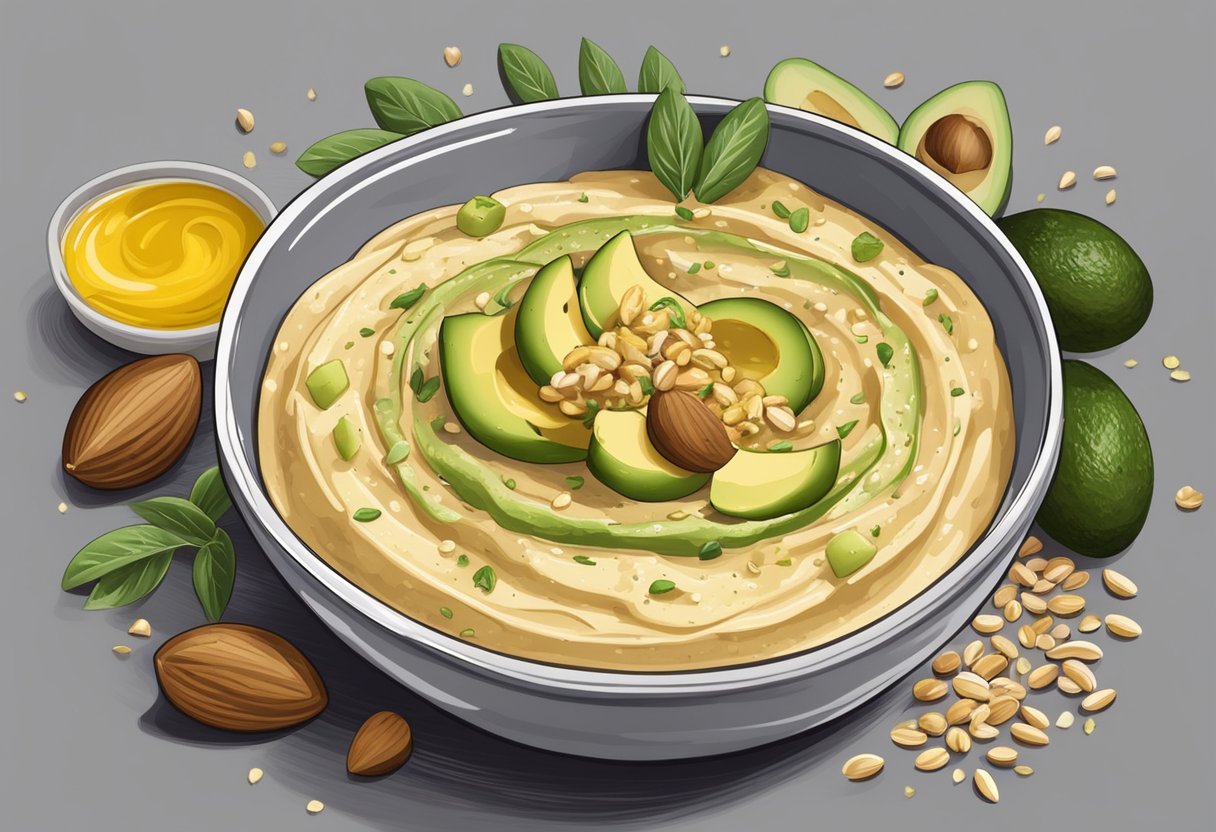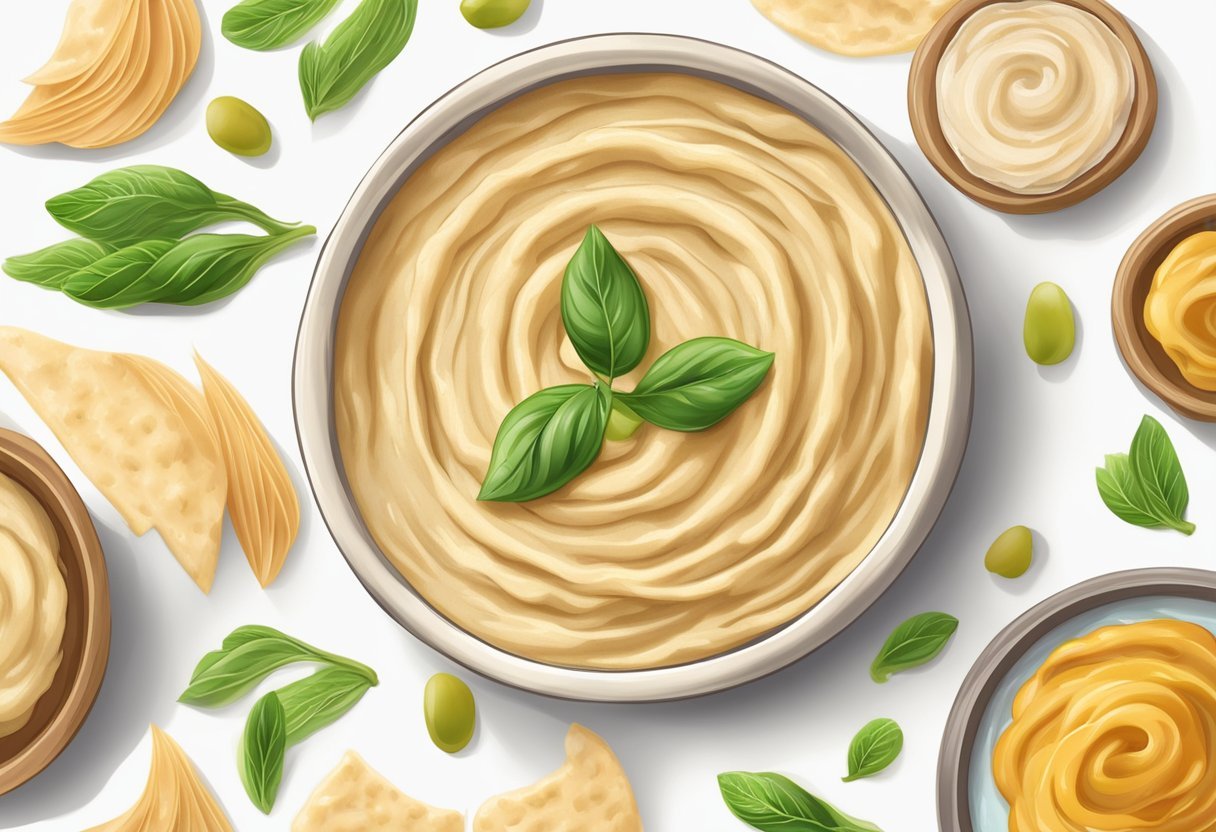How Hummus and a Natural Diet Can Combat Candida?
A Holistic Approach
This article is part of our series on Natural Health
Discover > Natural Health > How Hummus and a Natural Diet Can Combat Candida?
Candida is a naturally occurring fungus in the human body, and under normal conditions, it remains harmless. However, when there is an overgrowth of Candida, it can lead to various health issues, including infections. One common approach to manage Candida overgrowth is through dietary changes, and hummus can play a significant role in this process.
A properly balanced diet can help decrease the proliferation of Candida, and hummus, a popular Middle Eastern dish made from chickpeas, can be a healthy addition to such a diet. Rich in fiber, protein, and a variety of essential nutrients, hummus is not only delicious but also beneficial for overall health. More importantly, it is versatile enough to be included in numerous meals and snacks, making it an easy ingredient to incorporate into a Candida management plan.
When it comes to selecting the right hummus for a Candida treatment plan, it is essential to consider specific ingredient choices and preparation methods. Homemade hummus can be tailored to the unique requirements of those battling Candida overgrowth, ensuring it remains a healthful addition to the diet.
Understanding Candida
Candida is a type of fungus that naturally occurs in the human body, particularly in the mouth, intestines, and skin. Candida albicans is the most common species responsible for causing various infections referred to as candidiasis. In healthy individuals, the presence of candida is harmless and kept in check by the body's natural defense mechanisms and other microorganisms.
However, under certain circumstances, such as a weakened immune system or use of antibiotics, the balance of microorganisms in the body can be disrupted. This can lead to candida overgrowth, which may cause various health issues ranging from mild to severe. Some common manifestations of candida overgrowth include yeast infections, oral thrush, and more serious systemic infections.
Yeast infections are one of the most common forms of candidiasis and mainly affect women. Symptoms include itching, burning, and a thick, white discharge. Oral thrush, on the other hand, is an infection that occurs in the mouth and is characterized by white patches on the tongue and inner cheeks.
The treatment for candida overgrowth typically involves the use of antifungal medications. In addition to medical treatment, diet can play a crucial role in managing the overgrowth of candida. Certain foods or ingredients, like hummus, can help restore balance in the body and prevent future outbreaks.
Complications and Symptoms of Candida Overgrowth
Candida overgrowth can lead to a variety of health issues. The symptoms resulting from this common yeast infection can vary from mild to severe, affecting various body systems. Some of the common complications experienced by individuals include fatigue, bloating, and gas. These gastrointestinal symptoms can cause discomfort, disruptions to daily activities, and reduced overall well-being.
In addition to digestion-related issues, Candida overgrowth may also manifest as inflammation and rashes on the skin. This is because the yeast can disrupt the normal balance of beneficial microorganisms on the skin, leading to skin infections and irritation. Persistent itching is another symptom that may arise in affected areas, causing further discomfort.
A weakened immune system can be both a cause and a consequence of Candida overgrowth. When the immune system is compromised, the body struggles to keep Candida in check, leading to an overgrowth. In turn, the presence of excessive yeast can cause inflammation and other complications, further straining the immune system.
Nausea and diarrhea are additional gastrointestinal symptoms that may arise as a result of Candida overgrowth. These symptoms can be not only uncomfortable but also dehydrating, impacting overall health.
In conclusion, Candida overgrowth can lead to a range of complications and symptoms, including fatigue, rashes, bloating, inflammation, nausea, diarrhea, gas, itching, and a weakened immune system. Addressing this common issue through dietary and lifestyle changes, such as incorporating a Candida diet and avoiding foods like hummus, can help alleviate these symptoms and restore overall health.
The Role of Diet in Candida Overgrowth
A well-balanced diet plays a crucial role in managing Candida overgrowth. Many of the foods individuals consume daily contribute to the growth and spread of this yeast. The Candida diet focuses on reducing or eliminating those food items that promote the overgrowth of Candida.
One of the primary factors that contribute to Candida overgrowth is the consumption of sugar (how long does sugar last?), including processed foods, simple sugars, and added sugars. These sugars provide an easy energy source for Candida, allowing it to grow and multiply rapidly. Therefore, reducing sugar intake is an essential step in controlling Candida growth.
In addition to sugars, different sources of carbohydrates affect Candida growth. High-glycemic index foods like white bread, pasta, and rice can also contribute to overgrowth. It is highly advised to replace them with low-glycemic index options.
Healthy fats, such as olive oil and avocado, should be incorporated into the Candida diet. These fats provide long-lasting energy without increasing blood sugar levels, unlike carbohydrates and sugars. Additionally, they possess anti-inflammatory properties that support the immune system in fighting Candida overgrowth.
Dairy products can be another contributing factor to Candida growth, mainly due to lactose - a type of sugar found in dairy. It is essential to limit the consumption of dairy products, especially those high in lactose, such as milk and soft cheese. One can opt for low-lactose or lactose-free alternatives, like certain types of hard cheese and non-dairy milk options.
In summary, a proper Candida diet should focus on reducing sugar and carbohydrate consumption, incorporating healthy fats, and limiting dairy products. By making these dietary adjustments, one can create an environment that is unfavorable for Candida overgrowth, ultimately bringing the yeast's growth under control.
Identifying Unhealthy Dietary Habits
It is essential to recognize and address unhealthy dietary habits when treating Candida. Consuming foods and beverages that promote Candida growth can prolong the infection and make symptoms worse.
One unhealthy habit is the consumption of alcohol. Alcohol can weaken the immune system and increase sugar levels in the body, providing an ideal environment for Candida to thrive. Reducing or eliminating alcohol consumption is a crucial step in the Candida treatment process.
Another common aspect of an unhealthy diet is the intake of gluten-containing grains, such as wheat, rye, and barley (how long does barley last?). These grains can cause inflammation in the gut, leading to a compromised immune system and an imbalance of gut bacteria. It is advisable to avoid these grains and opt for gluten-free alternatives.
Meat can also play a role in exacerbating Candida overgrowth. Processed meats, in particular, may contain harmful additives and hormones that can disrupt the balance of gut flora. Choosing high-quality, lean, and preferably organic meats can help minimize this risk.
Corn is another food item to monitor when treating Candida. Corn-based products often contain mold and other harmful substances that can aggravate the infection. Limiting or eliminating corn from the diet can reduce the risk of mold exposure and support overall gut health.
In conclusion, identifying and addressing unhealthy dietary habits, such as consuming alcohol, gluten-containing grains, processed meats, and corn, greatly benefit the treatment of Candida overgrowth. Adopting a healthier diet focused on whole, natural foods is key to supporting immune function and maintaining balanced gut flora.
Building a Healthy Candida Diet
A balanced and healthy Candida diet focuses on consuming adequate protein along with a variety of non-starchy vegetables. This approach ensures that your body receives essential nutrients to support a strong immune system and keep Candida under control.
Incorporating whole grains such as oats (how long do oats last?), buckwheat, millet, (how long does millet last?) and quinoa (how long does quinoa last?) into your diet can be beneficial, as they provide a good source of fiber and can aid in digestion. These grains are also less likely to feed Candida, unlike refined carbohydrates.
Adding nuts and seeds to your meals ensures a boost of healthy fats and protein. They also serve as an excellent source of essential vitamins and minerals. Nuts like almonds (how long do almonds last?), walnuts (how long do walnuts last?), and pecans (how long do pecans last?) are versatile and can be included in snacks or salads.
Eggs are an essential part of a healthy Candida diet, as they are a high-quality protein source and provide essential vitamins and minerals. They can be prepared in various ways, such as boiled, scrambled, or in an omelette with non-starchy vegetables for added nutrients.
Legumes, although higher in carbohydrates compared to other protein sources, are still a valuable component of a healthy Candida diet. They offer a good amount of protein, fiber, and are low in fat. Including legumes such as chickpeas, lentils (how long do lentils last?), and black beans in moderation helps to maintain a balanced diet.
It is essential to base your meals around non-starchy vegetables like leafy greens, broccoli, cauliflower, and bell peppers, as they are low in calories and sugar. They also provide essential vitamins, minerals, and antioxidants, contributing to your overall health and well-being.
By incorporating these components into your daily meals, you can build a healthy Candida diet that promotes long-term wellness and aids in controlling Candida overgrowth. Just remember to monitor portion sizes and maintain a balanced diet to achieve optimal results.
The Role of Healthy Fats and Oils
Incorporating healthy fats and oils in the diet is crucial for combating Candida overgrowth. These beneficial fats help reduce inflammation and improve overall gut health, making it harder for Candida to thrive.
Olive oil is an excellent choice for adding healthy fats to the diet. It is rich in monounsaturated fats and antioxidants, which support a strong immune system and promote better gut health. Including olive oil in salad dressings or drizzling it over roasted vegetables are simple ways to incorporate it into a Candida diet.
Another source of healthy fats is avocado. High in monounsaturated fats, fiber, and several essential vitamins, avocados are a nutrient-dense food that helps maintain healthy digestion. Consuming avocado in the form of guacamole, blended into a smoothie, or added to a salad can provide valuable nutrients and support gut health.
Coconut oil is also a beneficial addition to a Candida diet. It contains medium-chain triglycerides (MCTs), which have antifungal properties and help suppress the growth of Candida. Incorporating coconut oil into daily cooking, or even taking it by the spoonful, can provide the body with these antifungal benefits.
In conclusion, introducing healthy fats like olive oil, avocado, and coconut oil into the diet can significantly contribute to improving gut health and supporting a balanced gut flora in the fight against Candida. Incorporating these nutrient-dense sources of healthy fats can be done in various delicious ways, making it an enjoyable aspect of a Candida-combating diet.
Understanding the Role of the Gut Microbiome
The gut microbiome, also known as the microbiota, is a complex ecosystem of microorganisms that live in our gastrointestinal tract. It consists of a diverse group of bacteria, fungi, and viruses. These microorganisms play a crucial role in maintaining our overall health, from digestion and metabolism to boosting the immune system.
One of the primary functions of the gut microbiome is to help with the breakdown and absorption of nutrients. Certain bacteria produce enzymes that aid in the digestion of complex carbohydrates, proteins, and fats. These beneficial bacteria also help synthesize vitamins, such as vitamin K and B12.
A balanced gut microbiome is crucial for maintaining a healthy immune system. The majority of our immune cells reside in the gastrointestinal tract, constantly interacting with the gut microbiota. This interaction helps to regulate the immune response, protecting us from harmful pathogens and limiting inflammation.
The composition of the gut microbiome is influenced by various factors, including diet, lifestyle, and genetics. A well-balanced diet, rich in diverse, fiber-rich foods, promotes the growth of beneficial bacteria while limiting the growth of potentially harmful microorganisms. Probiotics, live bacteria and yeasts that are beneficial to our health, can also help maintain or restore the balance of the gut microbiome, especially after an illness or antibiotic use.
When it comes to treating Candida, a common fungal infection, diet plays a significant role in managing this condition. It is essential to incorporate foods that support a balanced gut microbiome, such as hummus, which is a good source of proteins, fibers, and healthy fats. By nourishing the gut microbiome and maintaining a balanced flora, our body is better equipped to keep Candida growth in check and prevent its overgrowth, which causes infection and inflammation.
Incorporating Probiotic and Fermented Foods
Incorporating probiotic and fermented foods (What wine goes well with fermented foods?) into a diet aimed at treating Candida can greatly improve gut health and balance the digestive system. Fermented foods, such as sauerkraut and kimchi (how long does kimchi last?), are rich in beneficial bacteria, which can help restore a healthy gut environment. Including them in your daily meals can significantly impact your overall health and prevent Candida overgrowth.
Garlic is another essential ingredient to consider when pursuing a Candida-fighting diet. It contains potent antifungal properties that inhibit the growth of Candida, and in addition, can improve the immune system. Incorporating garlic into dishes like hummus can enhance both the flavor and nutritional value of your meal.
Probiotics are crucial in maintaining a healthy balance of intestinal flora, which in turn helps to keep Candida in check. Consuming probiotic-rich foods like yogurt, kefir, and kombucha effectively supplements the body's supply of good bacteria. It is recommended to choose unsweetened and unprocessed products to ensure the best results.
In summary, incorporating probiotic and fermented foods into a Candida diet by regularly consuming products like yogurt, sauerkraut, and garlic, can lead to a substantial improvement in gut health. These ingredients support an environment that discourages the growth of Candida, creating a path towards better overall health.
Benefits of Dietary Fiber
Dietary fiber offers numerous health advantages, playing a crucial role in preventing and alleviating various conditions. It is a vital component of a healthy diet, and many health experts recommend its regular consumption.
A primary benefit of dietary fiber is its ability to support regular bowel movements. It helps in preventing constipation by softening stools and increasing their bulk. In addition, fiber plays a role in maintaining a healthy gut environment by promoting the growth of beneficial bacteria, which aid in digestion and improve overall gut health.
Another important advantage of fiber is its ability to regulate blood sugar levels. By slowing down the absorption of sugars from the digestive system, fiber assists in maintaining stable blood sugar levels, reducing the risk of developing type 2 diabetes and helping manage the condition in those who have it.
Furthermore, dietary fiber may help lower cholesterol levels, particularly the harmful LDL cholesterol. It does this by binding to cholesterol particles and preventing their absorption into the bloodstream, thus promoting heart health and reducing the risk of cardiovascular diseases.
Incorporating fiber-rich foods like hummus, which is made from chickpeas, into your diet can play a vital role in weight management. Fiber-rich foods require more chewing, which triggers satiety signals, making you feel full for longer periods and reducing overall calorie intake.
In summary, a diet rich in fiber, such as one that includes hummus, can provide essential health benefits, including improved digestive health, blood sugar regulation, and heart health, as well as assisting with weight management. Emphasizing foods with high fiber content is an excellent way to ensure a balanced and nutritious diet.
The Need for Dietary Changes and Cleanse
Treating Candida overgrowth often requires dietary changes and a comprehensive cleanse. Candida is a type of yeast found naturally within the digestive tract, and when its growth becomes disproportionate, it can lead to various health issues. A well-planned detox regimen, accompanied by specific dietary changes, can help restore the balance and support overall well-being.
Incorporating a Candida diet is essential to control and reduce the symptoms of Candida overgrowth. The diet should primarily focus on eliminating sugar, refined carbohydrates, and yeast-containing foods that can aggravate the condition. When adopting a Candida diet, hummus could be a suitable and nutritious option for individuals as it contains protein and healthy fats, and it offers a flavorful addition to meals.
A candida cleanse could be a significant part of treating this condition. The cleanse aims to flush out the excessive Candida from the system and improve the overall gut health. Generally, the cleanse involves consuming a blend of antifungal supplements, probiotics, and natural herbs known for their cleansing properties.
Detoxifying the body is another essential aspect for individuals struggling with Candida overgrowth. Drinking ample water, incorporating anti-inflammatory foods, and consuming plenty of fiber-rich fruits and vegetables are a few ways to encourage the body's natural detoxification process. Regular exercise and adequate sleep are also crucial for supporting the immune system and detoxification.
In conclusion, addressing Candida overgrowth necessitates a comprehensive approach involving dietary changes, a candida cleanse, and detoxification. A well-structured plan, backed by consistency and commitment to change, can significantly improve gut health and overall well-being.
Potential Health Benefits of Treating Candida
Treating Candida overgrowth can lead to several health benefits, especially for individuals experiencing chronic symptoms associated with this condition. By managing Candida levels, one can experience improved digestive function, enhanced immune response, and increased energy levels.
One noticeable health benefit of treating Candida is improved gut health. Candida often compromises the balance of good and bad bacteria in the gut. By addressing this overgrowth, the balance can be restored, promoting better digestion and nutrient absorption. This, in turn, can help alleviate common symptoms such as bloating, gas, and irregular bowel movements.
Another advantage of treating Candida is its potential to strengthen the immune system. Candida overgrowth can lower immunity, making one more susceptible to various illnesses. By keeping Candida levels in check, the body is better equipped to fend off infections and maintain optimal health.
Incorporating anti-fungal foods, such as garlic and coconut oil, into the diet can help address Candida overgrowth. Limiting the consumption of processed sugars and carbohydrates, which can feed Candida, is also beneficial. Certain probiotic-rich foods and supplements can aid in restoring the balance of gut bacteria and further support the body in combating Candida overgrowth.
Keeping Candida under control can result in increased energy levels. Individuals with Candida overgrowth often report feelings of fatigue and lethargy. By addressing this issue, one can enjoy heightened vigor and improved mental clarity.
In summary, tackling Candida overgrowth offers a host of potential health benefits that can lead to an improved quality of life and overall well-being. By incorporating a balanced diet and embracing healthy lifestyle habits, one can effectively manage Candida levels and enjoy the benefits of a healthier body.
Why Hummus Fits into a Candida Diet
Hummus, a popular dish made from blended chickpeas, tahini, olive oil, and various seasonings, can be a suitable addition to a Candida diet. A Candida diet aims to limit the growth of the Candida yeast in your body by cutting down on foods that may encourage its growth. This includes avoiding sugary, processed, and high carbohydrate foods.
In a Candida diet, incorporating hummus can have various benefits. The chickpeas found in hummus are rich in protein and fiber which aid in satiety, leading to a feeling of fullness for an extended period. This helps in reducing the consumption of high-sugar, processed snacks that could promote Candida growth.
Hummus is also abundant in various essential vitamins and minerals such as iron, calcium, and B vitamins. These nutrients promote proper functioning of the immune system, which plays a vital role in keeping Candida growth under control.
Additionally, the healthy fats present in hummus come from olive oil and tahini (how long does tahini last?), which are both sources of monounsaturated fats. These fats not only contribute to overall health but may also have potential antifungal properties, further assisting with Candida control.
When incorporating hummus into a Candida diet, it is crucial to pay attention to portion sizes and pair it with the right foods. For example, avoid consuming hummus with refined carbohydrates such as white bread or crackers. Instead, opt for fresh vegetables such as cucumber, celery, or carrot sticks for a more balanced and Candida-friendly snack.
In summary, hummus can serve as an excellent addition to a Candida diet due to its nutritional value and potential antifungal benefits. Remember to consume hummus in moderation and pair it with suitable food items to maintain a healthy balance and assist in managing Candida growth.
Coping with Chronic Conditions
Chronic conditions like diabetes and celiac disease can complicate an individual's dietary choices, especially when dealing with a Candida overgrowth. A tailored treatment plan that considers both the Candida diet and specific needs for diabetes or celiac disease is essential.
When following a Candida diet, hummus can be a convenient and nutritious option. Individuals with diabetes benefit from the low glycemic index (GI) of chickpeas, the main ingredient in hummus. The low-GI means that the carbohydrates in chickpeas break down slowly, limiting blood sugar spikes and aiding in blood sugar control. Incorporating hummus into balanced meals can help manage diabetes alongside the Candida diet.
For those living with celiac disease, it's vital to verify that the hummus is gluten-free, as most traditional recipes are. However, keep an eye out for potential cross-contamination from other gluten-containing foods during manufacturing or preparation. Seek out gluten-free labeled hummus brands or make your hummus at home using simple ingredients like chickpeas, tahini, lemon juice, garlic, and salt.
Combining the Candida, diabetes, and celiac-friendly requirements into a meal plan may seem daunting at first. Here are some suggestions for incorporating hummus into a nutritionally balanced diet while managing chronic conditions:
Opt for whole, unprocessed foods and avoid added sugars, refined carbs, and gluten.
Pair hummus with fresh cut vegetables like cucumber, bell peppers, or celery for a low-carb, gluten-free, and Candida-safe snack.
Experiment with creative recipes using hummus as a base for salad dressings, dips, or even gluten-free wraps and sandwiches.
Constantly monitor blood sugar levels and adjust meals or snacks accordingly.
Utilizing hummus as part of the Candida diet can help ease some challenges of managing diabetes and celiac disease. By staying mindful of ingredients and food choices, individuals with chronic conditions can successfully maintain a healthy and Candida-friendly lifestyle.
Safeguarding Against Candida-related Infections
Maintaining a healthy diet can play a significant role in preventing and treating Candida-related infections. Eating foods that promote a healthy immune system, like those found in a Candida diet, helps the body effectively combat yeast overgrowth. One such food option is hummus, which can contribute beneficially due to its nutrient-rich ingredients.
Hummus is typically made from chickpeas, tahini, olive oil, and spices, which are all elements that encourage a strong immune system. Chickpeas contain B vitamins, zinc, and selenium, which can enhance the body's defense against infections. Tahini, made from sesame seeds (how long do sesame seeds last?), is a rich source of various essential minerals and antioxidants. Moreover, olive oil, known for its healthy fats, can also contribute to an improved immune response.
In order to integrate hummus into a Candida diet, it is crucial to ensure that its ingredients do not contribute to the growth of Candida yeast. For instance, many store-bought hummus brands may contain additives, sugars, and preservatives that could exacerbate a Candida overgrowth problem. Therefore, it is recommended to make hummus at home using natural and whole ingredients. Utilizing fresh herbs and spices, like garlic and turmeric, allows for an added layer of flavor while also providing potential anti-inflammatory and antimicrobial properties.
It is essential to remember that each individual's body can react differently to various foods and ingredients. Monitoring how the body responds to hummus inclusion in the Candida diet can help in making informed decisions about whether to continue consuming it. If any adverse reaction occurs, it may be best to avoid hummus and enlist the guidance of a healthcare professional.
Qualities of an Anti-Candida Diet
An anti-candida diet aims to reduce the growth of Candida, a type of yeast that can cause infections in the human body. This diet focuses on incorporating healthy, natural foods that support gut health and the immune system, while avoiding processed and sugary foods that may increase the growth of yeast.
One of the key aspects of an anti-candida diet is adopting a gluten-free approach. Since gluten can cause inflammation and weaken the gut lining, removing it from the diet can help improve the overall condition of the gastrointestinal system. This allows for a more effective fight against Candida overgrowth.
Foods rich in anti-inflammatory properties should be included, as they can assist in restoring the body's natural balance and reducing the symptoms of Candida overgrowth. These may include foods high in omega-3 fatty acids, such as fish and nuts, as well as colorful fruits and vegetables, which are rich in antioxidants and phytonutrients.
Here are some key components of an effective anti-candida diet:
Fruits and vegetables: Opt for low-sugar fruits like berries and non-starchy vegetables such as leafy greens, broccoli, and cauliflower.
Lean proteins: Focus on consuming high-quality protein sources like chicken, turkey, fish, and eggs.
Healthy fats: Incorporate sources of healthy fats, such as avocados, olive oil, and nuts.
Fermented foods: Include probiotic-rich fermented foods like plain yogurt, kefir, sauerkraut, and kimchi.
It is crucial to eliminate certain foods from the diet that can contribute to Candida overgrowth. These primarily include processed and sugary foods, as well as refined carbohydrates and alcohol.
In summary, an effective anti-candida diet should be gluten-free, rich in anti-inflammatory foods and nutrients, and exclude processed and sugar-laden items. By following these guidelines, individuals can create a supportive environment within their bodies to combat Candida overgrowth and improve overall gut health.
Choosing Organic and Farm-raised Foods
Organic and farm-raised foods play a vital role in a Candida diet. These foods help ensure that you are consuming high-quality, nutrient-dense ingredients. By opting for organic and farm-raised produce, you are more likely to avoid harmful chemicals and promote overall health while treating Candida.
Farm-raised fish provide an excellent source of protein and healthy fats for those following the Candida diet. By choosing farm-raised fish, you can avoid exposure to contaminants and ensure that the fish are raised in a controlled, humane environment. Look for fish that are raised without antibiotics or chemicals to ensure the highest quality.
Organic whole foods such as fruits, vegetables, grains, and legumes should be a staple in a Candida diet. These foods are grown without synthetic pesticides, herbicides, or fertilizers, which can lead to a healthier, more balanced gut flora. Consuming organic whole foods can also help decrease the risk of complications associated with Candida overgrowth.
Buying locally-sourced foods can also improve the quality and freshness of the ingredients you incorporate into the Candida diet. Visiting local farmers' markets and food co-ops enables you to get in touch with the sources of your food and gain a better understanding of how it is produced.
By choosing organic and farm-raised foods, you are not only promoting your own health but also supporting sustainable and responsible agricultural practices. These choices are essential for those following a Candida diet and seeking to improve their overall well-being.
Beverage Choices on a Candida Diet
When following a Candida diet, it's essential to make wise beverage choices that support overall health and combat the overgrowth of Candida. A primary focus should be on hydration, as it helps flush out toxins and prevents constipation. Though water is a usual option, there are other drinks that can provide benefits in this diet.
Herbal teas have been traditionally used to alleviate gastrointestinal symptoms and maintain a healthy digestive system. In a Candida diet, caffeine-free teas, such as chamomile, peppermint, and ginger tea, are helpful choices. Ginger tea, in particular, possesses antifungal properties and aids in promoting healthy digestion.
However, beverages containing caffeine should be avoided, as they may stimulate the growth of Candida and weaken the immune system. Thus, it's essential to stay away from coffee, black tea, and energy drinks.
Apple cider vinegar is another suitable beverage option in a Candida diet. Dilute a tablespoon or two of raw, unfiltered apple cider vinegar in a glass of water and drink it before meals. Its acetic acid content helps restore the natural pH balance in the body and creates an unfavorable environment for Candida overgrowth. Moreover, apple cider vinegar contains enzymes that support digestion and improve nutrient absorption.
It's also important to stay away from sugary drinks, such as sodas, fruit juices, and sweetened teas as sugar can feed Candida and exacerbate the problem. Overall, when selecting beverages for a Candida diet, choose those that promote digestive health and support your body's natural defenses against fungal overgrowth.
Artificial Sweeteners and Sugar Substitutes
When treating Candida, it is essential to limit sugar intake, as sugar can feed the yeast and promote its growth. However, many individuals still desire a sweet taste in their foods, which leads to the use of artificial sweeteners and sugar substitutes. Some alternatives to consider include erythritol (how long does erythritol last?), xylitol, and stevia.
Erythritol is a sugar alcohol naturally found in fruits and fermented foods. It has a low-calorie count and does not significantly impact blood sugar levels. In the Candida diet, erythritol can be a beneficial option as it does not promote the growth of yeast.
Xylitol is another sugar alcohol derived from plant sources like corn, birch bark, and hardwood. It has a taste similar to sugar but contains fewer calories. Unlike erythritol, xylitol has been found to have mild anti-fungal properties, making it a suitable addition to a Candida diet. However, be aware that excessive consumption of xylitol can cause digestive disturbances.
Stevia is a popular sugar substitute extracted from the leaves of the Stevia rebaudiana plant. It is calorie-free and has little effect on blood sugar levels. Studies have suggested that stevia might even possess some anti-fungal properties against Candida species.
While erythritol, xylitol, and stevia are considered generally safe and helpful options for those following a Candida diet, it is essential to remember that moderation is key. Consuming excessive amounts of these sugar substitutes can still contribute to digestive issues and may not necessarily eliminate all Candida symptoms.
When considering the use of artificial sweeteners, it is crucial to choose products wisely. Some artificial sweeteners like aspartame, sucralose, and saccharin may not be suitable for a Candida diet, as their safety and impact on yeast growth are still debatable. It is best to consult a healthcare professional or nutritionist when incorporating sugar substitutes into your diet to determine the most suitable options for your individual needs.
Spices with Antifungal Properties
Ginger and cinnamon are two spices known for their antifungal properties, making them an ideal addition to a Candida diet hummus. Not only do they add flavor to the dish, but they also help to keep the growth of Candida in check.
Ginger has been used for centuries in traditional medicine for its antimicrobial and anti-inflammatory properties. Its active compounds, like gingerol, have been shown to inhibit the growth of Candida, especially when combined with other antifungal agents.
Similarly, cinnamon has potent antifungal properties, attributed to its active compounds such as cinnamaldehyde. Like ginger, cinnamon can help control the growth of Candida by disrupting the growth of fungal cells.
When preparing your Candida diet hummus, consider incorporating these two spices to create a flavorful and healthful dish. You can start by adding a half teaspoon of ginger and a quarter teaspoon of cinnamon for a balanced flavor. You can adjust the amount according to your taste preferences and tolerance.
In addition to ginger and cinnamon, adding garlic and turmeric to your hummus can further boost its antifungal properties. Garlic contains allicin, which is known for its antifungal and antimicrobial activities. Turmeric, on the other hand, contains curcumin, a compound that can inhibit the growth of Candida while also reducing inflammation.
To fully enjoy the benefits of these spices with antifungal properties, make sure you're using them in their natural, unprocessed forms. Consuming them in their whole state will ensure that you're getting the most out of their nutrients and beneficial compounds. So, when preparing your Candida diet hummus, opt for fresh ingredients and avoid processed spice blends that might contain added sugars or other unwanted substances.
Seeking Medical Advice and Monitoring
Before starting any dietary changes to treat Candida, consulting with a healthcare provider is crucial. They can assess the individual's unique circumstances, provide an appropriate diagnosis, and recommend the best course of action. It is essential to rely on human studies and evidence-based practices to determine the most effective treatments for Candida overgrowth.
The role of the digestive system in maintaining overall health cannot be overstated. A balanced diet plays a significant role in preventing Candida overgrowth and ensuring the smooth functioning of the digestive system. The healthcare provider may suggest certain modifications to the individual's diet, such as incorporating or avoiding particular foods like hummus, depending on the individual's needs and response to treatment.
Regular monitoring of an individual's response to dietary changes is vital. Tracking progress, noting any improvements or worsening of symptoms, and updating the healthcare provider regularly helps to adjust the treatment plan as needed. Moreover, it is advisable to remain vigilant about potential side effects or complications that could arise from any dietary modifications.
Managing blood sugar levels can also play a crucial role in treating Candida, as high blood sugar can promote yeast growth. It is essential to work closely with the healthcare provider for optimal blood sugar control, especially for those with diabetes or other underlying conditions. In some cases, a healthcare provider might recommend dietary modifications like reducing intake of carbohydrates and incorporating nutritional supplements.
Remember that treating Candida with a well-planned and nutritious diet requires commitment, consistency, and patience. Consulting with a healthcare provider ensures that the individual receives the most appropriate and evidence-based recommendations for their unique circumstances. Regular monitoring of progress and adherence to the suggested treatment plan will help in achieving the best possible outcomes in managing Candida overgrowth.
Stress Management and Candida Overgrowth
Stress is a significant factor that can contribute to Candida overgrowth. When the body experiences stress, it releases cortisol, a hormone that suppresses the immune system. A weakened immune system is less capable of keeping Candida in check, allowing it to multiply and potentially lead to an overgrowth.
Incorporating stress management techniques into one's lifestyle can help prevent Candida overgrowth and promote overall wellness. Some effective stress management strategies include:
Meditation: Practicing mindfulness meditation regularly can help reduce stress levels and improve mental clarity. By focusing on their breath, individuals can bring their attention to the present moment and become more aware of their thoughts and feelings.
Exercise: Engaging in regular physical activity, such as jogging, dancing, or yoga, can help release tension and boost endorphin levels, leading to reduced stress levels and improved overall well-being.
Sleep: Ensuring that one is getting enough quality sleep each night is crucial for stress management. Establishing a consistent sleep schedule and creating a comfortable sleep environment can help promote restful sleep.
Healthy Diet: Consuming a balanced diet rich in fruits, vegetables, lean protein, and whole grains can help support the immune system, making it more resilient to stress-related Candida overgrowth.
Social Support: Building a strong social network can help provide emotional support during stressful times, which will better equip individuals to manage stress.
By implementing stress management techniques, individuals can improve their overall health and reduce the likelihood of Candida overgrowth. It is essential to remember that a comprehensive approach, which includes a healthy diet like the Candida diet hummus, stress management strategies, and possibly other treatments, will be most effective in addressing Candida overgrowth.
Supporting Digestion to Control Candida
A healthy digestive system is crucial in controlling Candida overgrowth. By promoting proper digestion, we can create an environment less hospitable to the growth of Candida and other harmful microorganisms. It's essential to focus on several factors in supporting digestion, including nutrient absorption, and maintaining the integrity of the GI tract.
A balanced diet, rich in fiber and nutrients, is necessary for optimal digestion. Incorporating fruits, vegetables, whole grains and legumes can enhance the functioning of the GI tract, ensuring efficient breakdown and absorption of essential nutrients. Adequate hydration is also vital for maintaining healthy digestion, as it helps in breaking down food and absorbing nutrients.
Moreover, including fermented foods like yogurt, kefir, and sauerkraut in the diet can provide the body with beneficial probiotics. These friendly bacteria support the healthy gut microbiome, which plays a significant role in digestion and nutrient absorption. Probiotics also help in maintaining the balance of microorganisms in the GI tract, preventing the overgrowth of harmful bacteria like Candida.
Another crucial aspect of supporting digestion is the management of stress. Chronic stress can negatively impact the digestive system, leading to imbalances in gut bacteria and impairing digestive functions. Practicing relaxation techniques like deep breathing, meditation, and yoga can be beneficial for managing stress and promoting optimal digestion.
In conclusion, focusing on diet, hydration, gut microbiome, and stress management can significantly contribute to healthier digestion and help control Candida overgrowth.
Coping with Gluten Intolerance and Candida Overgrowth
Individuals dealing with gluten intolerance and candida overgrowth face unique challenges when it comes to finding dietary options that suit their needs. Thankfully, there are numerous gluten-free grains available that can help create delicious and satisfying meals. Incorporating these grains into the diet can aid in managing both conditions effectively.
Quinoa, millet, buckwheat, and rice are some examples of gluten-free grains that can be safely consumed by those with gluten intolerance. These nutritious alternatives offer an array of health benefits, such as being rich in fiber, vitamins, and minerals. Moreover, they can be easily used in recipes as substitutes for gluten-containing ingredients.
In addition to incorporating gluten-free grains, individuals with candida overgrowth should pay attention to their sugar intake. Sugar feeds the candida yeast, causing it to multiply rapidly. Thus, minimizing the consumption of refined sugars and high-carbohydrate foods is crucial in managing this condition. Instead, focus on consuming complex carbohydrates from sources like vegetables and legumes, which provide essential nutrients without causing rapid yeast growth.
It is essential to maintain a balanced and varied diet that includes natural, unprocessed foods. Some ideal choices for individuals with gluten intolerance and candida overgrowth include:
Leafy greens, such as spinach and kale
Non-starchy vegetables, like broccoli and cauliflower
Healthy fats from avocados, olive oil, and nuts
Protein sources, including lean meats, fish, and eggs
By implementing these dietary strategies alongside a gluten-free grains-focused approach, individuals with gluten intolerance and candida overgrowth can effectively cope with their conditions while enjoying a wide range of delicious, nutritious meals.
Natural Health Solutions for Vitamin Depletion, Skin Health, and Personal Care
Natural health practices can provide a range of benefits for vitamin depletion, skin health, and personal care. Birth control can deplete certain vitamins and minerals from the body, including vitamin B6, vitamin B12, and magnesium. It's important to work with a healthcare professional to monitor vitamin levels and consider supplementing with natural sources of these nutrients.
Lemon balm is a natural ingredient that can provide a range of benefits for skin health, including reducing inflammation and promoting healthy collagen production. This herb can be used in a variety of natural skincare remedies, including toners, masks, and moisturizers.
Making solid perfume is a natural and eco-friendly alternative to traditional liquid perfumes. This process involves melting natural ingredients like beeswax and jojoba oil together with essential oils to create a long-lasting and customizable fragrance.
Chlorophyll is a natural ingredient that can help to reduce body odor by neutralizing odors and promoting healthy digestion. This ingredient can be found in a range of natural personal care products, including deodorants and oral care products.
By incorporating natural health practices into your daily routine and making healthy choices for your vitamin depletion, skin health, and personal care, you can support your overall health and well-being in a sustainable and holistic way. It's important to do your own research and consult with a healthcare professional before using any new remedies or making significant changes to your diet or lifestyle.
#hummus candida diet #minced garlic #fungal infections #fresh lemon juice #intestinal tract
















